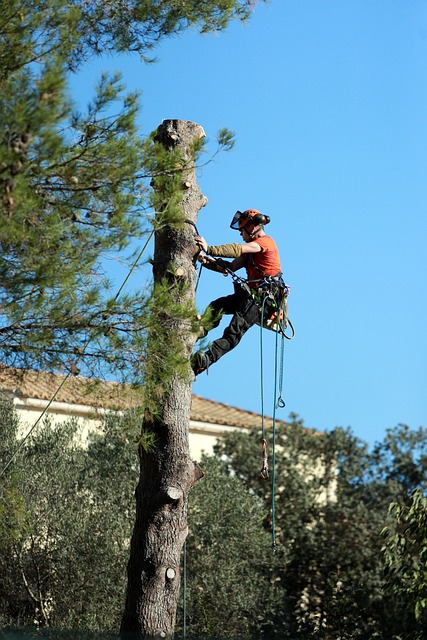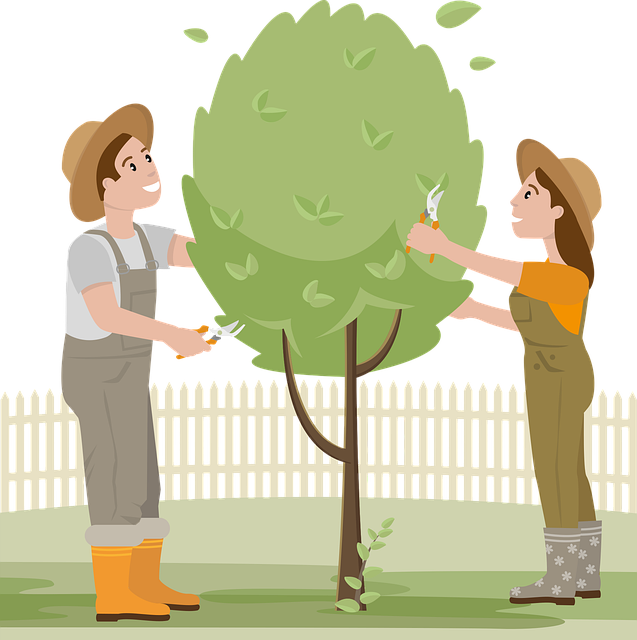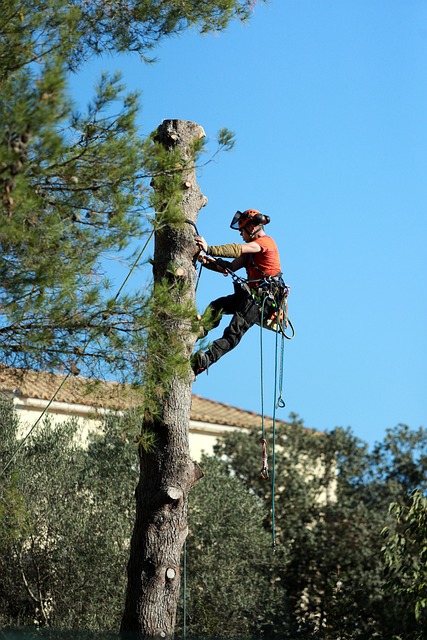In Palmer, maintaining ecological balance is crucial, with professional tree removal services like Tree Removal Palmer playing a pivotal role. Dead trees and stumps serve as breeding sites for a diverse insect population, including those that can become pests. These habitats must be managed to prevent infestations that threaten both tree health and community safety. Regular removal of deadwood is essential to mitigate risks of nutrient cycling disruptions, greenhouse gas emissions, and wildfire hazards, as well as to support understory vegetation regeneration and soil health. In Palmer, the presence of deadwood beetles like pine engravers and red-haired pine beetles can weaken coniferous trees, leading to carpenter ant infestations that pose structural risks. Prompt detection and management of these pests are vital to prevent their spread. Tree Removal Palmer services are indispensable for the safe removal of hazardous trees before they become breeding grounds for wood-boring insects, aligning with environmental regulations. Post-removal, stump grinding or chemical treatments are recommended to eradicate stumps and reduce infestation risks. Maintaining a healthy landscape involves good drainage, aeration, the introduction of organic mulch, diversifying plant species, and regular monitoring to ensure an insect-free environment. By adhering to these practices, residents can effectively minimize the risk of future pest issues while promoting a thriving ecosystem in Palmer.
Dead trees and stumps can serve as ideal breeding sites for a variety of insects, posing potential infestation risks on your property. In the picturesque town of Palmer, understanding the lifecycle of these arboreal remnants and their role in harboring pests is crucial for effective pest management. This article delves into the environmental impact when leaving such structures untouched and outlines the benefits of professional tree removal services in Palmer, like Tree Removal Palmer, to safeguard against insect invasions. We will explore the common insect species that thrive in decaying wood, effective stump removal techniques to deter these pests, and maintenance strategies to maintain an insect-free environment post-removal.
- Understanding the Lifecycle of Dead Trees and Their Role as Insect Breeding Grounds
- The Environmental Impact of Leaving Dead Trees and Stumps Intact
- Identifying Common Insect Species Attracted to Decaying Wood in Palmer
- The Importance of Professional Tree Removal Services in Palmer for Pest Prevention
- Effective Stump Removal Techniques Post-Tree Felling to Deter Insects
- Maintenance Strategies After Tree and Stump Removal to Keep Your Property Insect-Free
Understanding the Lifecycle of Dead Trees and Their Role as Insect Breeding Grounds

Dead trees and stumps serve as critical habitats for a variety of insect species, many of which can become pests if their populations explode. As part of the lifecycle of these insects, they often lay their eggs in the crevices of decaying wood or bark, providing a sheltered environment for their offspring to hatch and develop. Understanding this ecological role is essential for homeowners and arborists who aim to manage potential infestations on their property. In the context of tree removal in Palmer, where the climate supports a diverse array of insect life, it’s crucial to address dead trees promptly. Tree service professionals like those at Palmer Tree Service can assess the condition of trees and determine when removal is necessary. This proactive approach not only mitigates the risk of infestations but also safeguards the health and safety of the surrounding ecosystem. By removing dead trees, which serve as breeding grounds for insects that can harm living trees or invade homes, property owners can significantly reduce the likelihood of encountering pests like carpenter ants, termites, and wood-boring beetles. It’s a preventative measure that maintains the balance between wildlife habitats and residential environments.
The Environmental Impact of Leaving Dead Trees and Stumps Intact

Dead trees and stumps, if left intact, can have significant environmental impacts. In ecosystems, decaying organic matter plays a crucial role in nutrient cycling; however, over time, the presence of large numbers of dead trees can disrupt this balance. The decomposition process releases carbon stored in the trees, which contributes to greenhouse gas emissions. Moreover, such standing deadwood can harbor pathogens and invasive species that might eventually affect surrounding live vegetation, potentially leading to further tree mortality and biodiversity loss.
From an ecological standpoint, removing dead trees through services like Tree Removal Palmer is often necessary to maintain forest health and diversity. This action helps prevent the spread of decay-causing fungi and insects that can weaken and ultimately kill adjacent trees. Additionally, timely removal of deadwood reduces the risk of wildfires by eliminating fuel sources. It also allows for the regeneration of understory vegetation, which is vital for maintaining soil quality and supporting a variety of wildlife species. Thus, while the environmental impact of leaving dead trees and stumps intact can be detrimental, their removal as part of a comprehensive land management strategy can help preserve ecological balance and promote a healthier forest environment in the Palmer area and beyond.
Identifying Common Insect Species Attracted to Decaying Wood in Palmer

In Palmer, as decaying trees and stumps provide habitats for various insect species, it’s crucial to recognize the common pests that are attracted to this environment. Deadwood beetles, such as the pine engraver and red-haired pine beetle, often infest coniferous trees, contributing to their decline. These beetles not only weaken the structural integrity of the trees but also facilitate the proliferation of other wood-boring insects like carpenter ants, which excavate wooden nest galleries and can compromise the safety of nearby structures. Identifying these infestations early is key to managing the spread of these pests. Professional tree removal services in Palmer play a vital role in this process by safely and efficiently removing dead trees that are likely to become breeding grounds for such insects. By implementing regular tree maintenance and prompt removal, residents can effectively reduce the risk of infestations on their property.
Furthermore, fungal growth in decaying wood creates an ideal environment for ambrosia beetles, which introduce fungi into sound wood, further compromising tree health. The presence of these beetles often precedes the visible signs of decay and can lead to the rapid spread of tree disease. To mitigate this risk, it’s advisable to engage with local arborists who specialize in tree removal in Palmer. These experts not only ensure the safe removal of potentially hazardous trees but also provide valuable insights into maintaining a healthy landscape free from pests and diseases. Regularly scheduled tree assessments and prompt action against decay can significantly diminish the likelihood of future infestations, thereby safeguarding the health of the community’s trees and the safety of its inhabitants.
The Importance of Professional Tree Removal Services in Palmer for Pest Prevention

Maintaining a healthy and pest-free landscape in Palmer is a year-round endeavor, particularly when it comes to addressing the presence of dead trees and stumps. These decaying structures are not just unsightly; they also serve as hotspots for pests like termites, carpenter ants, and beetles. Professional Tree Removal Palmer services play a critical role in mitigating these risks. Certified arborists with specialized equipment can safely and efficiently remove dead trees before they become breeding grounds for harmful insects. By doing so, these services prevent the spread of infestations to healthy trees and shrubbery, safeguarding your property from costly damage. Furthermore, employing expert tree removal professionals ensures compliance with local regulations and environmental considerations, making it a responsible choice for maintaining both the aesthetic appeal and the structural integrity of your outdoor spaces in Palmer. With their expertise, these services can also advise on preventative measures to keep your trees and your home secure from pest invasions, thereby protecting one of your most valuable assets.
Effective Stump Removal Techniques Post-Tree Felling to Deter Insects

When a tree reaches the end of its natural lifespan or becomes hazardous, it’s crucial to enlist professional tree removal services like those offered in Palmer. Effective stump removal post-felling is essential to deter insect infestations that can compromise the health of your remaining trees and landscaping. Traditional methods for stump removal include grinding, which involves using a machine equipped with a rotating wheel or blade to grind the wood into chips and sawdust, effectively removing the stump below the ground level. This method is particularly effective in Palmer’s diverse environmental conditions and can significantly reduce the likelihood of infestations from beetles and other wood-boring insects that thrive on decaying wood. Another approach is chemical treatment, where euthanating agents are applied directly to the stump to accelerate its decomposition. This method should be handled by experts due to the potency and potential environmental impact of the chemicals involved. In Palmer’s arboreal-rich settings, it’s imperative to address stumps promptly to maintain a healthy and pest-free environment for your trees and outdoor spaces. Both stump grinding and chemical treatments are viable options in Palmer, with the former often preferred for its immediate results and minimal environmental disturbance.
Maintenance Strategies After Tree and Stump Removal to Keep Your Property Insect-Free

After the successful removal of dead trees and stumps by a professional service like Tree Removal Palmer, maintaining your property’s insect-free status requires diligent strategies. One key approach is to thoroughly clean up the removal site, ensuring no remnants such as roots or sawdust are left behind, as these can serve as breeding grounds for pests. Stumps should be ground down to a level with the surrounding soil to prevent them from becoming new habitats for insects. Regularly inspecting the area for any signs of new growth or infestation is crucial.
Furthermore, employing landscaping practices that promote good drainage and aeration can deter pests. Mulching the area with organic material can enrich the soil while deterring some insect species. Additionally, maintaining a diverse plant life can naturally keep pest populations in check, as different plants attract different types of beneficial insects. It’s also advisable to remove any fallen trees or branches promptly and to keep the surrounding vegetation trimmed and healthy. By adhering to these maintenance strategies, property owners in Palmer can significantly reduce the risk of future insect infestations following tree and stump removal.
Tree removal in Palmer is a critical measure for safeguarding against insect infestations, particularly when dead trees and stumps serve as ideal breeding habitats for these pests. Understanding the lifecycle of decaying wood and the environmental implications of leaving such structures intact underscores the necessity for proactive tree care. By employing professional tree removal services in Palmer, residents can effectively address the issue, minimizing the risk of future infestations. Complementary stump removal techniques and post-removal maintenance strategies further enhance the protection of properties from unwanted insects. It is clear that a diligent approach to tree and stump management plays a pivotal role in maintaining a healthy and pest-free environment.
